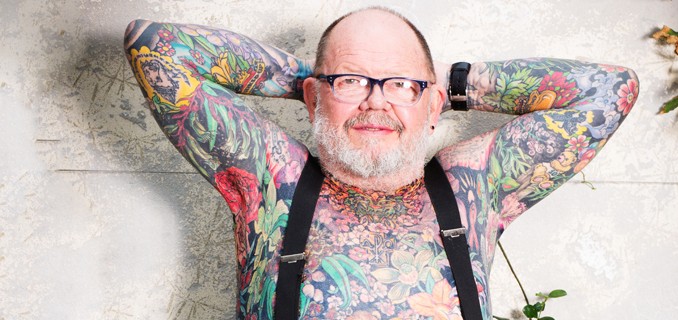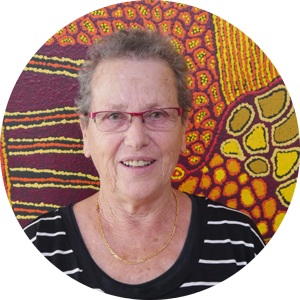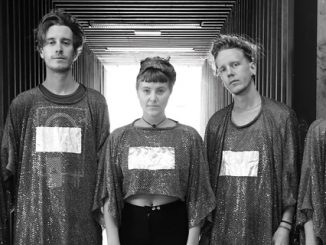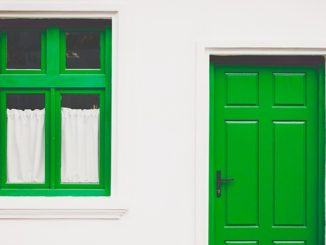
Age is still considered by many to be limiting, yet retirement often emerges as the most liberating period of life. Hannah Craft spoke to two Inner Westies who have embarked upon extraordinary journeys in their senior years.
Age carries with it a host of negative associations. The most ungenerous of these is the idea that retirement is the beginning of the end; that here the trajectory of life commences its descent.
Geoff Ostling of Petersham is living proof to the contrary. A lifelong Sydneysider and former history teacher, Geoff Ostling, 69, feels that he is in his prime. “I’m busier now than I ever was working full time.” In his retirement Geoff found the freedom to fulfil a dream he had been nursing for decades: a full body tattoo.
Geoff’s love of tattoo art was evident as early as five years old when he quizzed sailors about their ink. The first time he saw a tattoo he asked his father, an Anglican pastor, what it was. He received a thoroughly disapproving reply.
The turning point came at Sydney’s very first Sydney Tattoo Show, where at 38 years of age Geoff met a man named Merv Chapman. It was the first time he had ever seen a full body tattoo. “I just loved it, I thought it was wonderful,” he recalls. He knew then that this was what he wanted.
He later visited Merv Chapman at his home in Glebe; Merv was something of a local character. He gave Geoff some words of wisdom: to choose a theme for his body art and adhere to it.
When confronted with this decision, Geoff considered what had been most meaningful in his life, what had shaped him as a person. His thoughts landed on Sydney, his lifelong home. The result is a full body tattoo of around seventy native Sydney wildflowers, interspersed with images of the city and symbols alluding to past experiences.
Geoff was 42 when he first got inked. It had not been an option in his youth. “Nice middle-class boys didn’t have ink.” Teachers were also not allowed visible tattoos. And so his first tattoo was the beginning of a journey, which he initially had to pursue in secret. It was only after retirement that Geoff found the freedom to please nobody but himself.
“It was a totally liberating experience. I could do what I wanted to do.”
 For Judi Muller, retirement was not the fulfilment of a lifelong dream but the forging of a new one. Born in Belgium, Ms Muller’s family migrated to Australia in 1948 when she was eighteen months old. In her retirement, Judi has transformed her Balmain home into a gallery sourcing and selling Aboriginal art.
For Judi Muller, retirement was not the fulfilment of a lifelong dream but the forging of a new one. Born in Belgium, Ms Muller’s family migrated to Australia in 1948 when she was eighteen months old. In her retirement, Judi has transformed her Balmain home into a gallery sourcing and selling Aboriginal art.
Although she was always interested in visual art, Judi’s career was in early childhood education. After growing up in Sydney’s Eastern Suburbs she worked in childcare centres for ten years. In 1976 she got a job with the Department of Community Services where she worked as a Children Services Advisor. She left in 1985 for a teaching position at TAFE, where she taught childcare workers for twenty years before retiring.
It was only then that she formed a particular interest in Aboriginal art. “When I retired, after a year or so I thought ‘Oh my god, what am I going to do for the rest of my life?’ It was a long time. I started looking at Aboriginal art and I started doing whatever short course I could find.”
In pursuit of her new passion Judi happened upon Honey Ant Gallery. The owner was impressed with Judi’s knowledge and offered her a part time position while she was on maternity leave. “And I was like, shit yes.”
Judi’s watershed experience came just before she took the job. Judi determined that she could not work in an Aboriginal art gallery without having been to the remote communities where a lot of the art was created. She packed up and went into the desert for two weeks.
What greeted her in the desert was deeply confronting. The quality of life was unlike anything she had witnessed in Australia. It was like another country she had never known existed until she was there. Yet it sparked an important epiphany that would shape her life hereafter: the connection between Aboriginal art and Aboriginal rights.
Judi’s gallery, Mulapa Aboriginal Art, based in Rozelle, operates under strict principles. She is meticulous about the ethics of the dealers she buys from, visiting them in Alice Springs to ensure the artists are dealt with fairly and respectfully. In an industry ripe with counterfeit and corruption, there are only two private dealers she trusts enough to purchase from. Thus Mulapa has become Judi’s own effort to furthering Aboriginal rights. “I want Aboriginal art in people’s homes, because that, a blackfeller once said to me, will do more for Reconciliation than anything else.”
Judi and Geoff share a renewed sense of vigour and purpose in their senior years, unfettered from the bonds of careers and conventions that shaped their youth.
“I could do what I wanted to do,” Geoff marvels, recalling his first years of retirement and the energy sparked by this new freedom. “I didn’t have to get up in the morning, I didn’t have to do anything. But I was driven to do things all the time.”
For him, the tattoos that now mark his entire body are not simple decoration. They tell with intimate and heartbreaking clarity the story of his life. They map his devotion to his homeland, his faith in love and goodness in the world. They recall the loss of his beloved partner in the AIDS crisis, and the joy of finding love again. Every design has meaning, and the freedom to decorate himself has been the freedom to express what he holds dear.
In these markings his story will endure. When Geoff passes, his skin will be be tanned and donated to the National Gallery of Australia.
Judi’s story is one of a quiet crusader. In founding Mulapa, she does not merely immerse herself in a lifelong passion. For her, promoting ethical Aboriginal art is an act of reconciliation; an act she hopes is catching on. Art is the seed she sows about herself, a seed that blossoms into awareness and understanding.
“You bring a bit of Aboriginal culture into your home and there’s a connection. Your horizons broaden… maybe you start to ask questions,” she says. “I see art as one way of bringing that issue into the white man’s world.”
Judi and Geoff are both active members of the Inner West community. You may happen upon Judi’s art stall at the next community event. You will still see Geoff at church on Sundays. He has stayed true to the faith of his upbringing despite finding a unique path through life. He has never received any serious resistance from his family.
As Geoff points out, he didn’t really break the rules. “I promised my mother I’d only get one tattoo, and that’s what I did. One very big tattoo.”
Words: Hannah Craft

